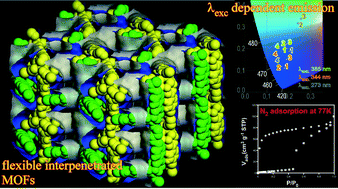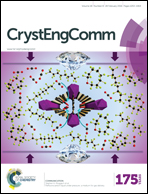Controlling interpenetration for tuning porosity and luminescence properties of flexible MOFs based on biphenyl-4,4′-dicarboxylic acid†
Abstract
Four new compounds based on zinc(II) or cadmium(II) metal ions and elongated dicarboxylate and bipyridine ligands, namely, {[Cd3(μ4-bpdc)3(H2O)2]·DMF}n (1), {[Zn3(μ4-bpdc)3(μ-bpdb)]·5DMF}n (2), {[Zn2(μ4-bpdc)2(μ-bpdb)]·7DMF}n (3), and {[Zn4(μ4-bpdc)3(DMF)(μ4-O)(H2O)]·7DMF·3H2O}n (4), (where bpdc = biphenyl-4,4′-dicarboxylate, bpdb = 1,4-bis(4-pyridyl)-2,3-diaza-1,3-butadiene, DMF = dimethylformamide) have been synthesised under solvothermal conditions and structurally characterised by single crystal X-ray diffraction. The crystal structures range from 2D (in 1) to 3D (2, 3, and 4) systems according to the coordination mode acquired by the bpdc ligand and the presence of an ancillary linker. Compound 1 consists of stacked Cd-bpdc neutral layers containing isolated small voids. The coordination of the bpdb ligand (2 and 3) or the formation of a tetrahedral Zn4O cluster (in 4) generates highly open 3D architectures that share the structural feature of being doubly interpenetrated. A careful computational analysis on the crystal structures permits unravelling their void systems. Moreover, characterising the photoluminescence emission of the compounds at variable excitation wavelengths provides an opportunity to couple the luminescence response with their porosity, which could signify the potential utility of these materials as photofluorescent sensors for small adsorbates.


 Please wait while we load your content...
Please wait while we load your content...